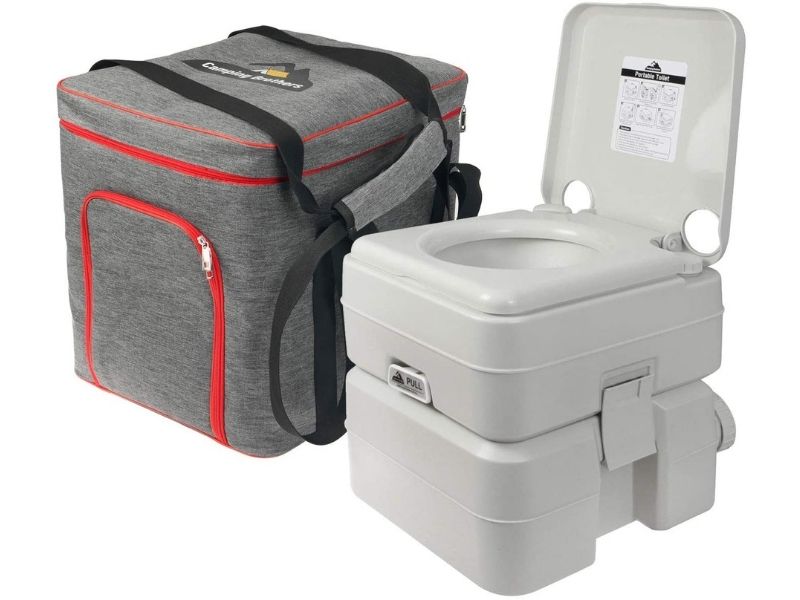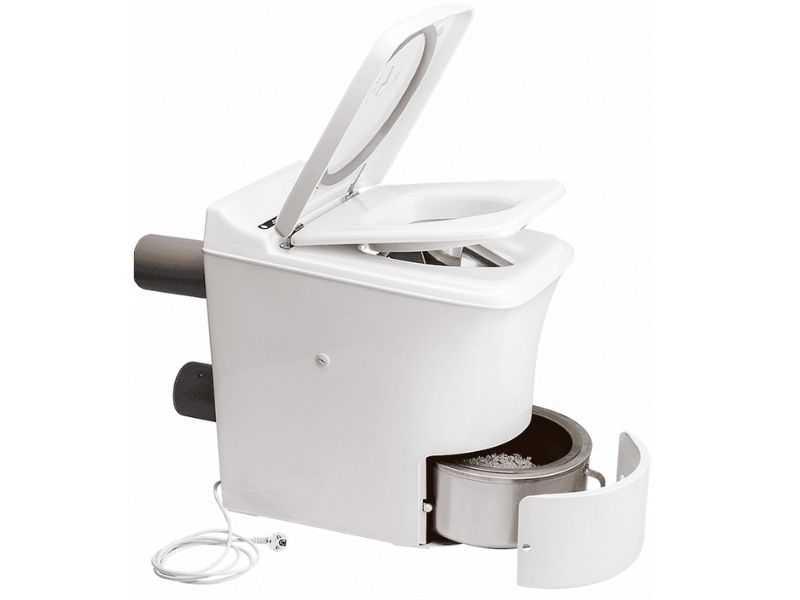Toilets with plumbing options are the most commonly preferred toilets with over 70% of individuals using these toilets. However, toilets with plumbing systems are curbed by numerous unavoidable problems that alter their efficiency. For example, blockages, worn washer bolts, condensation, and broken tanks are common problems with conventional toilets. All these problems necessitate regular repair services from a reliable plumber or, to some extent, overall replacement, leading to considerable costs to the owner or user.
The options for toilets with no plumbing are composting toilets, upflush toilets, portable camping toilets, and incinerating toilets. They have the advantages of not needing plumbing systems, low maintenance, and using little water. However, they can be costly to purchase and have a learning curve.
Toilets without plumbing systems are the ideal solution to such problems. With toilets without plumbing systems, such issues calling for immediate attention are minimal. Therefore, you should consider installing toilets without plumbing systems as a great option if you are bothered by such problems. Some of them work very well as off-grid toilet options.

Toilets with no plumbing: the options
Here are various types of toilets without plumbing systems you will quickly come across the market:
1. Composting toilet systems

Also known as dry toilets, composting toilets are toilets without plumbing designed to compost waste in a hygienic and environmentally friendly way. They are popular in homes and outbuildings. Notably, these kinds of toilets have been in existence for a long time.
They are well-known to hold human waste matter and converting it into inert nitrogen-rich material similar to humus. In addition, they are very compact with treatment chambers inside the toilet pedestal.
Dry toilets are easy to maintain, and the following are the various ways of taking care of them:
- Cleaning and operating compost toilets: They can be easily cleaned with readily-available materials that include brushes, ashes, cleansing materials, and lids for covering defection holes. You can clean the toilet seat with vinegar to avoid chemical cleaners.
- Changing vaults and removing compost: You only need a shovel, hoe, wheelbarrow, and tar for sealing openings of closed crypts.
- Repairing toilet and shelter: Materials used for construction such as cement, sand, boards, gravel, bamboo, wire, hammer, saw, nails, and trowels are used to repair the toilets quickly.
Living with composting toilets is quite easy for most homes.
2. Upflush toilets

Upflush toilets were invented in Saniflo in 1958. These no plumbing toilets are well-known to operate effectively under current circumstances. They use a macerator pump held in a tank to move waste against gravity.
When the tank attains a certain level, a detecting sensor turns on power, and blades reduce waste into a sewer through a ¾ or 4-inch discharge pipe tied to the sewer. Due to this phenomenon, they are easily attached to your home without requiring additional plumbing or demolition.
Saniflo regards upflush toilets as maintenance-free. However, a plumber can compare them with convectional bathrooms identifying maintenance issues mainly clogs in the macerator. As such, most units are enhanced with access panels for cleaning the blades. In addition, the flush mechanism requires regular servicing, just like conventional toilets. There are many upflush toilet pros and cons to consider before installing one in your home.
3. Portable camping toilets

Portable camping toilets are widely-popular used toilets in camps, slums, construction sites, film locations, and outdoor gatherings. A single person can quickly move them around while others require special lifting equipment such as cranes.
These no plumbing toilets are unisex and come with portable fiberglass rooms with lockable doors and a receptacle that catches waste into a container.
There are various portable camping toilets available, including composting toilets, bucket toilets, freezing toilets, urine-diversion dehydration toilets, and container-based toilets. Not to forget, these toilets have no pits or drainage systems. Instead, they use chemical treatment methods.
Portable camping toilets are easy to maintain compared to plumbing toilets. The following are their maintenance approaches:
- Adding chemical disinfectants.
- Replacing broken toilet tops.
- Closing waste reservoirs using the T-handle back in.
- Cleaning the bathroom using water.
- Adding deodorants that dry the bathroom.
With proper care, portable camping toilets can be very handy and easy to use as well.
4. Incinerating Toilets

The incinerating toilets are without plumbing toilets designed to incinerate waste into small amounts of ash using electricity that homeowners empty regularly. These toilets do not require any water or additives. They only need an electrical power supply when the bathroom is in use. Notably, they are easy to take care of since they only require the owner to empty the ashes and fix power problems.
Benefits of toilets without plumbing
Toilets without plumbing come with many benefits. Here are five main advantages of using toilets without plumbing:
1. Limited Damages
Poorly constructed sewers will call for regular repairs that are difficult and costly. However, without plumbing, toilets are easy to maintain and need minimum repair hence less expensive. In addition, errors when installing without plumbing toilets are easy to correct, unlike conventional toilets that require a rigid approach.
2. Enhanced Flexibility
Conventional sewer toilets will require proper planning and set up in designated areas. On the other hand, most without plumbing toilets are flexible enough to be placed anywhere when the need arises. As long as you know how to vent a toilet and can find space for them, they’ll work as desired.
Importantly, plans for no plumbing toilets that require adjustment can be easily made unlike convectional toilets that result in extensive waste when they go wrong.
3. Do Not Require Septic Tanks
Without plumbing, toilets do not require septic tanks that are costly to buy, install, and maintain. Also, such tanks are more likely to cause discomfort through spillage or odor. Septic tanks emit odors even when covered, especially when debris falls into them.
4. Minimum Use of Water
Without plumbing toilets are dry toilets that do not require water flush systems. This makes them easy to maintain and friendly for individuals living in semi-arid areas and facing regular droughts. They are highly effective as they provide a much-desired hygienic disposal of waste.
5. Environmentally Sustainable and Conservation
Without plumbing toilets contribute to environmental sustainability and conservation. They have reduced the burden of treating human wastes on treatment plants. For example, sewage systems require fossil fuels that are environmental pollutants. In addition, more waste from sewage treatment plants quickly gets into water bodies such as lakes, oceans, and waterways.
How to choose toilets without plumbing
When choosing the right without plumbing toilets, here are some essential factors to consider:
Climatic Conditions
The no plumbing toilet should be tolerant to the temperature conditions of your area. Some dry toilets will not work well in extreme weather conditions.
DIY Friendliness
It would be best to determine whether you could comfortably install the toilet on your own. This may include building the outhouse, managing waste tanks, and hooking up plumbing. If you cannot, it implies you need professional assistance, which leads to extra costs.
Length of Use
Although the without plumbing toilet is a cheap and available option for short-term purposes, you may not use it for an extended period. Therefore, it is vital to consider choosing a toilet that will match your needs.
Design
The toilet design should favor your area preference as well as needs. It would help if you bore in mind its portability, durability, and user-friendliness when choosing the right design.
The legality of the toilet in your area
You should also consider if the toilet is legal and allowed in your area or not. Otherwise, you might run into issues with the authorities when installing and using the toilet.
Pros And Cons of The Toilet
Before choosing any without plumbing toilet, it is crucial to consider its pros and cons.
Pros of toilets without plumbing
- Highly flexible
- Low water consumption
- Less maintenance than toilets with plumbing systems
- Not harsh on the environment
- No bad odors around the house
- Save on space
- Improve the look of the home if designed well
Cons of toilets without plumbing
- Some require electricity to maintain which is costly
- Costly to buy
- Can be annoying to handle human waste
- Some have a learning curve to their usage
Always check the manufacturer’s manual to see how many people the bathroom can accommodate. Some toilets are designed for occasional use and will break down quickly when used regularly.
Bottom Line
It is possible to eliminate problems associated with toilets with plumbing systems. No plumbing toilets offer you bathroom functions that convectional toilets would, with more enhanced benefits. Don’t get stuck anymore! Consider choosing without plumbing toilets and get rid of problems associated with plumbing toilets and become the next saver.
